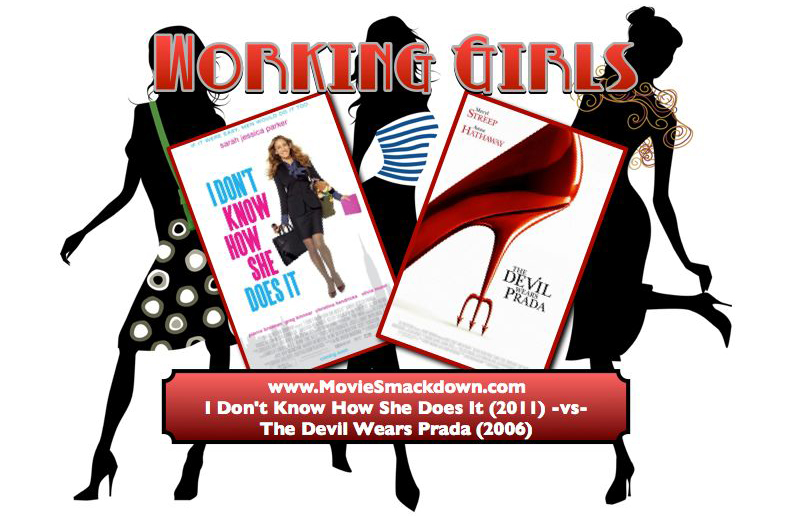
The Smackdown
A woman’s role today in the world is as vague and subject to interpretation as the U.S. Constitution. She can work or stay at home or both, but every choice comes with a price. Some women feel judged for their decision not to have families; others feel pressured to stay with their families and not work. And heaven help the women who try to master both feats with only two hands.
I Don’t Know How She Does It and The Devil Wears Prada examine the ever-so-popular and unfortunate double standard that exists between men and women in the workplace through the woman’s point of view. Both films ask the big question: What are women supposed to do? Both offer solutions. Two all-star casts. Two scripts adapted by screenwriter Aline Brosh McKenna from best-selling novels.
But which film more effectively gets its message across without sacrificing entertainment value? Let the Smackdown begin!
[singlepic id=1226 w=320 h=240 float=right]
The ChallengerÂ
I Don’t Know How She Does It is a romantic comedy disguised as a pseudo-documentary. It tells the story of Kate (Sarah Jessica Parker), a woman juggling a hundred balls at once, and combines it with documentary-style interviews with the characters. At home, Kate cares for her children and husband, cooks, plans birthday parties, takes the kids to school, and stays awake at night making lists for everything that needs to be done the following day. At work, she’s a successful businesswoman with her own office, assistant and incredible potential. Sounds like Superwoman, right? Too bad her life is a mess.
Kate takes on a huge project where she needs to do extensive traveling alongside her new partner, Jack Abelhammer (Pierce Brosnan). Jack is drawn to Kate right away and doesn’t hide it. Being away from home so much, especially with another man, causes a rift between Kate and her husband Richard (Greg Kinnear). Oh, and asking Richard for a little help at home is not a valid solution. He has a job of his own.
The interviews are used to give other characters’ opinions on Kate’s situation and the plight of women in general. Kate’s best friend, Allison (Christina Hendricks), is featured, along with stay-at-home mother Wendy (Busy Phillips); Chris Bunce (Seth Meyers), the man who’s out to get Kate’s project; and Momo (Olivia Munn), Kate’s assistant. Seeing how hard it is for a woman to have a family while trying to succeed at her, Momo decides never to have one. That doesn’t last very long.
[singlepic id=1227 w=320 h=240 float=right]
The Defending ChampionÂ
The Devil Wears Prada hit theaters in 2006 and unleashed one of the decade’s most horrible bosses in film, Miranda Priestly (Meryl Streep). The film was an instant success, drawing audiences with a cast that included Stanley Tucci, Anne Hathaway and Streep, who earned a record 14th Best Actress Academy Award nomination. Stepping out of the Disney spotlight and into films like Brokeback Mountain may have saved Hathaway from being typecast as cutesy princess forever. She fought for the role of Andy Sachs, Miranda’s new personal assistant, and as a result, grew into adulthood before the eyes of her young fans.
Andy accepts a position at a fashion magazine as an assistant to the editor, Miranda, and is immediately confronted with a choice – either quit or tolerate her boss’ cruel and unusual punishment for a year, after which she’ll be able to work pretty much wherever she wants. Our protagonist trudges onward and ends up surprising everyone, especially Emily, the first assistant, played by Emily Blunt. Blunt’s portrayal dazzled Hollywood, giving her future opportunities in films like The Young Victoria, The Jane Austen Book Club and Charlie Willson’s War.
The Scorecard
Screenwriter Aline Brosh McKenna and Director Douglas McGrath take a lot of creative risks with I Don’t Know How She Does It. Almost every scene with Kate includes a voice-over, which doesn’t help Sarah Jessica Parker break away from Sex and the City’s Carry Bradshaw. Kate also repeatedly breaks the invisible fourth wall to stop a scene and explain to the audience what’s happening. Sometimes this gets a laugh; other times, it simply kills the flow and undercuts the work of the rest of the talented cast, including Kinnear, Brosnan, Christina Hendricks and Kelsey Grammer.
But what I Don’t Know lacks in story, it makes up for in truth. The fact is, almost everything the characters say, however many times they say it, makes a strong case for real working mothers who also have to come home every night and put food on the table. Children like Kate’s son Ben, who doesn’t speak until age two, bear the brunt of the mother’s absence.
McKenna doesn’t take as many creative liberties with Prada, but this over-the-top script works because every character is well rounded and relatable. Just when the audience wants to hate Miranda most, she opens up to Andy for one moment and expresses sorrow for the loss of “another†husband. And just as we start to sympathize with her worries over how the crumbling marriage will affect her children, she quickly resumes her nasty ways.
Both films make an issue of appearances, with Prada making a much stronger visual impact than its rival tries to achieve by relying too heavily on dialogue. When we see Miranda for the first time, with her Cruella DeVil look, we know she’s evil, just like we see Andy’s innocence through her unfashionable wardrobe. Meanwhile in I Don’t Know, we pause for every character so Kate can explain their background.
The DecisionÂ
Where I Don’t Know How She Does It gives us occasionally funny but stereotypical characters, Prada connects at a far deeper level without trying to talk to audiences through a movie screen. The first film makes a statement, and a powerful one for its core audience, but the latter tells an interesting story that reaches its audience without them possibly ever realizing it.
I Don’t Know How She Does It will appeal to women, especially working mothers, but Prada accomplishes that same goal without repetition, stridency, flat characters or cinematic rule-breaking. Both men and women can identify with its story about workplace oppression, and it smartly shows two female characters succeeding by making different choices. We have to make a choice too, and in this case, it’s easy: The Devil Wears Prada is our still-fashionable winner.




Leave a Reply